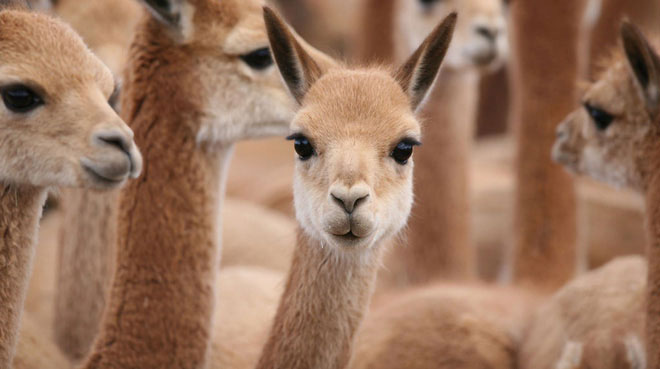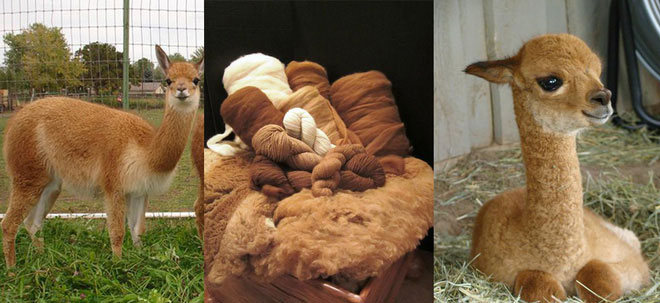Few people think this camel is the source of the world's rarest fiber fabric
Woolen fabric made from this camel's fur is even more valuable than Cashmere which is very expensive.
Compared to common camels, it is very lovely and charming. In particular, its fur can be woven into fabric like wool. And moreover, this fabric is extremely rare. Even today, it is still more expensive than other quality fabrics at least 5 times.
Animal icons for Peru country
In the past, only the Inca aristocracy (an Indian race in southern America) was allowed to wear Vicuña camel coat. It is so precious that it is called "golden fleece".
Camel Vicuña has the scientific name of Vicugna vicugna , living only in the high mountains of the Andes. It has a small body, big, innocent eyes like deer eyes and yellow fur. Visually, Vicuña camel is extremely charming and elegant.

Vicuña camel possesses super lovely looks.
In Peru, the country that owns the Andes part has a camel Vicuña growing, people see this animal as a national symbol, and take its picture printed on national flags, badges, coins.
Currently, Peru has about 2 million Vicuña camels.
Soft hair, thin yarn and especially insulating
During the Inca Empire, Vicuña camel was also seen as a divine animal. It is prohibited to kill it, and only use its feathers to weave clothing for the royal family.

Although outwardly charming, camel Vicuña is not a weak species.
Although outwardly charming, camel Vicuña is not a weak species. Because of its high altitude, and the harsh Andes mountains, it developed an enormous amount of red blood cells to increase oxygen utilization.
The digestive system of camel Vicuña also belongs to the same healthy product. It can grind the medium-dry and hard-grass grasses as easily as it does. But most notably, the coat of Vicuña camel. They include fluffy, soft, fluffy yarns with extremely high insulating properties.

The thick, smooth wool layer of the camel.
We all know, most wool products are charged, but Vicuña camel hair is not. Each of its yarns is only 12-14 microns thick, while Cashmere goat hair is nearly 19 microns, while wool is 25 microns.
In the textile industry, the thinner the natural yarn, the more valuable it is. In addition, Vicuña camel hair also grows very slowly so it is even more rare. At least, this "golden fleece" is also 5 times more expensive than Cashmere goat fur.
"It is the harsh nature that created a perfect Vicuña," said biologist Santiago Paredes Guerrero. "Its fur is also the best natural fiber of the earth" - he added.

In the textile industry, the thinner the natural yarn, the more valuable it is.
The past was tragic
Also because of the "golden wool" sound that for centuries after the fall of the Inca empire, Vicuña camel was hunted to become extinct.
Earlier, in the Inca period, people only harvested Vicuña camel hair every four years, and each time performed according to the solemn Chaccu ritual. But by 1532, when Inca was invaded by Spain, the invaders had frantically chased and killed the Vicuña camel population for lusting for their fur. From this time until the middle of the twentieth century, Vicuña camels were constantly killed by guns.
European aristocrats and Americans raced to represent the "golden fleece" jacket, considering it the value of nobility. The more they hunt for "golden fleece" , the more camel Vicuña will be killed, eventually remaining less than 10,000.
Difficult to preserve and restore glory
Unable to lose this most precious animal, in 1967, Peru decided to turn the 16,000-acre site at Lucanas into the first Vicuña sanctuary. By 1975, they banned the sale of Vicuña camel hair products abroad.

Today, the Vicuña camel kicks in the high mountains of the Andes.
Unfortunately, the black market is willing to pay 1,000 dollars (about 23.3 million dong) for 1 kg of "golden wool". The poachers are therefore still ignoring the law, and the security forces are helpless because the area needed to patrol is too large. The number of Vicuña camels therefore continues to decline without braking.
To deal with poaching, Peru changed tactics. They distributed the remaining Vicuña camel numbers to farmers to keep, allowing them to cut the feathers for sale. And very quickly, poor households changed their lives by selling Vicuña camel hair. Prior to that visible "livelihood" , people also fiercely fought poachers.
Today, Vicuña camels bounce around in the high mountains of the Andes, staring at their young eyes and waving their short tail. The period of hardship has passed so they are fluttering in the middle of the immense Peruvian wind.
- Technology time, even fabric can be woven from fiber, led
- The world's rarest silk weaves from the silk of millions of spiders
- Explore the mystery of the camel's hump
- New, super durable carbon fiber for sewing armor
- Fabric absorbs water from fog
- The cutest contest in the world
- Waterproof fabric thanks to its ability to drain water
- He developed a sensor cloth that tracks body movement
- The world's first human camel was born
- Unveiling super heat-resistant fabric with silver fiber
- How much is eating too much fiber?
- Video: The reason why camel milk is like 'white gold'
 Animal 'suffering' after hibernation
Animal 'suffering' after hibernation Why do goats climb well?
Why do goats climb well? Scientists were surprised to see chimpanzees eating turtles
Scientists were surprised to see chimpanzees eating turtles Giant catfish died deadly due to drought in Thailand
Giant catfish died deadly due to drought in Thailand